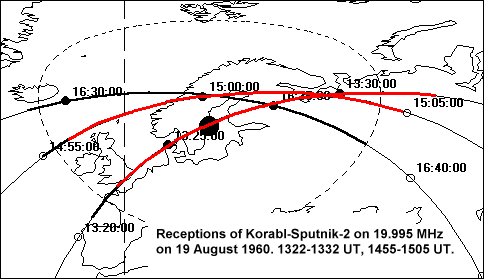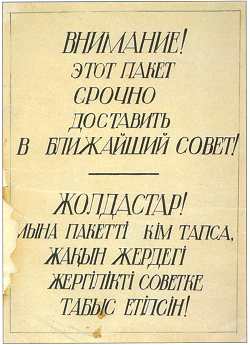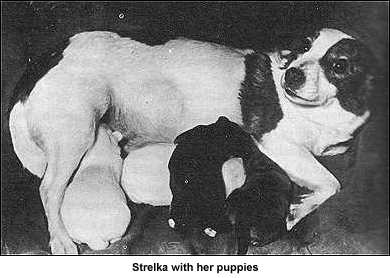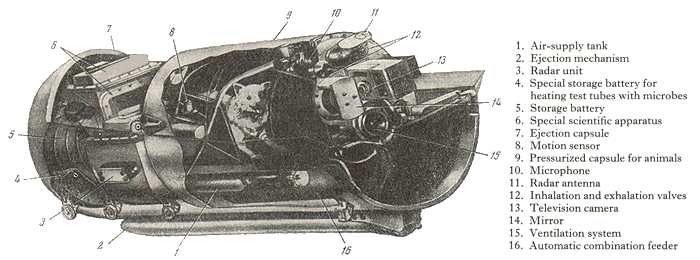 The
flight of Sputnik-5, a.k.a. Korabl-Sputnik 2
The
flight of Sputnik-5, a.k.a. Korabl-Sputnik 2 The
flight of Sputnik-5, a.k.a. Korabl-Sputnik 2
The
flight of Sputnik-5, a.k.a. Korabl-Sputnik 2
At ignition one of the combustion chambers in strap-on Block B or G burned through. The strap-on separated from the core at 17 seconds into the flight and the launch vehicle exploded at 28.5 seconds.
The problem with the booster
must have been easily identified and rectified, for Soviet planners pressed
on for another dog flight a mere 18 days later!
The launch of the next Vostok (1K) test flight had indeed been planned for 15 August but had to be rescheduled because of a faulty oxygen valve in the booster (3).
Korabl-Sputnik 2, popularly known as Sputnik-5, was finally launched at 0844:06 UT (3)] [There is a certain controversy as to the launch time. Sergei Voevodin gives the launch time as 0838:24 UT (2)] on Friday 19 August 1960 from the Baikonur Cosmodrome by a Vostok rocket into 297 x 324 kilometre orbit at 65.0 degrees inclination. It carried two dogs, Strelka and Belka, and other biological specimens including plants, rats and mice.
 The
launch announcement contained the usual items such as the mass of the spacecraft
4600 kg and the frequency 19.995 MHz for the "Signal" transmitter. The
signals
were indeed picked up by my friend Dieter Oslender in Bonn, Germany.
On the third revolution the Swedish Telecommunications Agency's monitoring
station at Enköping picked up the "Signal" beacon at 1322-1332 UT
and again at 1455-1505 UT (8). The map shows
clearly that these reception periods correspond almost exactly to the period
when the craft was above the station's horizon. It is interesting that
video
signals from the TV system onboard used to monitor the health of the
dogs were picked up by US intelligence.
The
launch announcement contained the usual items such as the mass of the spacecraft
4600 kg and the frequency 19.995 MHz for the "Signal" transmitter. The
signals
were indeed picked up by my friend Dieter Oslender in Bonn, Germany.
On the third revolution the Swedish Telecommunications Agency's monitoring
station at Enköping picked up the "Signal" beacon at 1322-1332 UT
and again at 1455-1505 UT (8). The map shows
clearly that these reception periods correspond almost exactly to the period
when the craft was above the station's horizon. It is interesting that
video
signals from the TV system onboard used to monitor the health of the
dogs were picked up by US intelligence.
The launch occurred on the last full day of the IAF Congress in Stockholm (read my account fo that memorable week here) and it made a great impression. Of course details about the flight were very scarce, and during a pre-planned press conference on August 19, Leonid Sedov only answered general questions and answered technical questions with "we have not yet been informed by Moscow about these details". Hermann Oberth, the german space pioneer, also participated in this press conference and said nice generalities about the flight. I, as a young man of fourteen, hovered in the background and stared at these luminaries!
Just as for Korabl-Sputnik 1 (Sputnik-4) the infrared horizon sensor failed and the retrorocket firing attitude had to be achieved by relying on a sun sensor. This operational mode was a back-up mode devised by Igor Yatsunskiy (5). The idea was to use specific launch time to have attitude for de-orbit burn with TDU engine looking directly to to the Sun.
In "The Soviet Encyclopaedia of Space Flight" (6) there is an interesting sketch (reproduced above) showing just how the back-up orientation worked. It shows the spacecraft adopting the solar attitude at exit from eclipse and then keeping this until the retro impulse vector was pointing slightly downwards. In (7) we can read:
In general, a single attitude sensor such as a sun sensor is not sufficient, you need at least two sensors to determine attitude (and then you may obtain two solutions and have to figure out a way to discard one). However, as Igor Lissov pointed out and Igor Yatsunskiy found out, if the sun direction coincides with the desired attitude a single sensor suffices. If you point the longitudinal axis of the spacecraft at the sun the roll orientation does not need to be controlled, only its rate."B E Chertok was in charge of the orientation system. It consisted of two redundant systems: an automatic/solar orientation system and a manual/visual orientation system. Either system could operate two redundant cold nitrogen gas thruster systems, each with 10 kg of gas .... The automatic solar orientation system consisted of solar sensors, DUS-L2 angle of flight sensors, and an SRB analogue computer unit. The TDU would only fire if the sun sensors - consisting of a slit arranged over three photocells - indicated correct orientation. The DUS-L2 angle of flight sensor utilized two-step double gyroscopes with mechanically opposed directions. The SRB used these inputs and generated impulses to carry out the burn."
Thus, the retro attitude was dictated by the sun. This means that there were launch window constraints dictated by the sun. Also, if you look at this in detail, the exit from sunlight had to take place near southern apex, otherwise the retro attitude would be, in the worst case (exit from eclipse at equator), 65 degrees +/-23.5 degrees (solar declination) from the flight path. Therefore, launches in the winter would produce a strange retro attitude even if the exit from eclipse was at the southern apex (which puts the sun near the orbital plane).
 Once
the retro attitude had been established gyros would be used to hold the
sun attitude. I think even rate gyros could be used, which probably are
spun up all the time anyway to provide a rate damping signal to the analog
computer that controls the attitude control thrusters.
Once
the retro attitude had been established gyros would be used to hold the
sun attitude. I think even rate gyros could be used, which probably are
spun up all the time anyway to provide a rate damping signal to the analog
computer that controls the attitude control thrusters.
On 20 August 1960 at approximately 1020 UT the retro-rocket fired 8000 km from the landing point. At approximately 1050 UT the ejector mechanism operated as a test for the Vostok ejector seat, and the container carrying Strelka and Belka continued descent under a parachute. The experiment container with the dogs landed at approximately 1102 UT - the spacecraft touched down nearby at about the same time.

